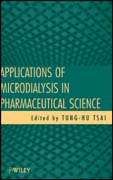
ÍNDICE: Chapter 1: Introduction to Applications of Microdialysis in Pharmaceutical Sciences. Chapter 2: Microdialysis in Drug Discovery. 1. Introduction.2. Phases of Drug Development. 3. Role of Biomarkers in Drug Development. 4. Role of Pharmacokinetic-Pharmacodynamic Modeling in Drug Development. 5. Role of Microdialysis in Drug Development. 6. Current Applications and Perspective of Microdialysis Sampling for Drug Development of Specific Therapeutic Groups.7. Regulary Aspects of Microdialysis Sampling in Drug Development. 8. Conclusions. Chapter 3: Analytical Considerations for Microdialysis Sampling. 1. Introduction. 2 Analytical Methodologies. Chapter 4: Monitoring Dopamine in the mesocorticolimbic and nigrostriatal systems by microdialysis: relevance for mooddisorders and Parkinson's disease. 1. Introduction. 2. Pathophysiology of Serotonin-Dopamine Interaction: Implication for Mood Disorders. 3. Dopamine Depletion in the Nigrostriatal System: ParkinsonS Disease. 4. Conclusions. Chapter 5: Monitoring Neurotransmitter Amino Acids by Microdialysis: Pharmacodynamic Applications. 1. Introduction. 2. Monitoring neurotransmitter amino acids by microdialysis. 3. Basic Research on receptors. 4. Psychostimulants and addictivedrugs. 5. Analgesia. 6. Ischemia/ anoxia. 7. Conclusion and perspectives. Chapter 6: Microdialysis as a tool to unravel neurobiological mechanisms of seizures and antiepileptic drug action. 1. Introduction. 2. Microdialysis to characterise the seizure-related neurobiological and metabolic changes in animal models and in humans. 3. Microdialysis as chemoconvulsant delivery tool in animalseizure models. 4. Microdialysis as an elegant tool to elucidate mechanisms of electrical brain stimulation and neuronal circuits involved in the generation and control of seizures. 5. Microdialysis to unravel the mechanisms of action of established antiepileptic drugs and new therapeutic strategies. 6. Microdialysis studies in search for mechanisms of adverse effects of clinically useddrugs, drugs of abuse and toxins. 7. Combination of microdialysis with other complementary neurotechniques to unravel mechanisms of seizures and epilepsy. 8. The advantage of microdialysis to sample biophase levels of antiepileptic drugs and to monitor central neurotransmitters as pharmacodynamic markers for their anticonvulsant activity. 9. Microdialysis as a tool to study relationships between epilepsy and its comorbidities. Chapter 7: Microdialysis in lung: Monitoring of exogenous and endogenous compounds. 1. Introduction. 2. Special aspects associated with lung microdialysis compared to microdialysis in other tissues. 3. Insertion of microdialysis probes into lung tissue. 4. Insertion of microdialysis probes in the bronchial system. 5. Types of probes. 6. Endogenous compounds. 7. Exogenous drugs. 8. Animal data. 9. Clinical data. 10. Comparison of pharmacokinetic data in lung obtained by microdialysis and other techniques. 11. Predictability of lung concentrations
- ISBN: 978-0-470-40928-2
- Editorial: John Wiley & Sons
- Encuadernacion: Cartoné
- Páginas: 542
- Fecha Publicación: 15/07/2011
- Nº Volúmenes: 1
- Idioma: Inglés
